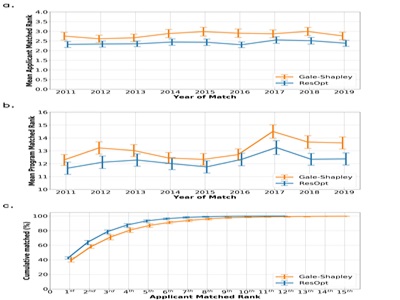Residency Matching Optimization
The algorithm of matching residency programs with medical students has remained unchanged for decades. By considering the preferences of both parties and computing a globally optimal pairing, this technology improves residency match results while increasing the efficiency of the process.

What is the Problem?
The current system of pairing medical students to residency programs has remained relatively unchanged for half a century. The existing methods for determining residency matching are based on the Gale-Shapley method, a "stable-marriage" method that prioritizes applicant outcomes. However, this leaves room for improvement; there is still an unmet need for an algorithm achieving optimal matches for both applicants and programs.
What is the Solution?
To solve this, the technology takes the form of a new matching algorithm. This algorithm is developed to optimize residency matching for both the applicants and programs involved, ensuring a win-win outcome for the system as a whole. The technology takes into account the preferences of both parties and computes a globally optimal pairing, resulting in more applicants matching their most preferred programs and better average ranks for both applicants and programs.
What is the Competitive Advantage?
The technology offers the following advantages:
- Matches applicants to their preferred programs more consistently (78.7%, vs 71.5%)
- Programs and applicants both achieve better average ranks, increasing by more than 3 places and half a place respectively
- Increased optimization means residents will have greater insight into which programs they are more likely to successfully match thus optimizing which programs, and how many, to apply to.
- And, programs can optimize their time by interviewing fewer candidates, but those most desirable that are likely to accept their offers.
- Broad applicability to any similar system, involving applicants submitting weighted preferences
-
swap_vertical_circlemode_editAuthors (1)Russell N. Van Gelder
-
swap_vertical_circlelibrary_booksReferences (2)
- Yue Wu, Theodore Spaide, Yuka Kihara, Cecilia S Lee, Ryan T Yanagihara, Julia Owen, Aaron Y Lee, Russell Van (2020-06), Global maximal utility optimizer for resident matching, Investigative Ophthalmology & Visual Science, 61, 5120
- Yue Wu, Cecilia S Lee, Aaron Y Lee, Russell N Van Gelder (2021-06), Algorithmic optimization of residency matching for a win-win outcome, Investigative Ophthalmology & Visual Science, 62, 2648
-
swap_vertical_circlecloud_downloadSupporting documents (1)Product brochureResidency Matching Optimization.pdf